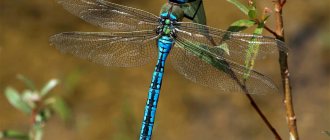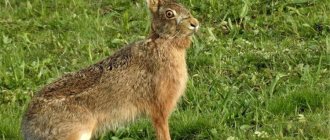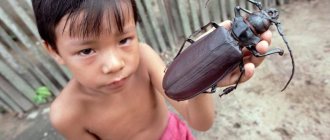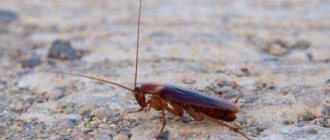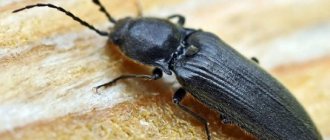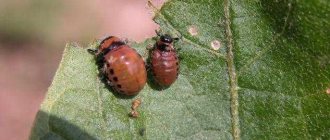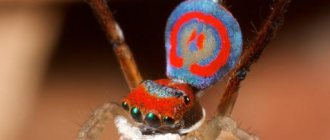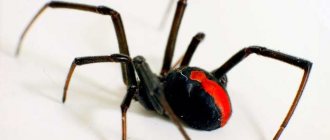Ecology
Our planet is home to a great variety of living creatures that are dangerous to humans, and they do not necessarily have to be large in size. Insects can cause a lot of harm. Insects have played an important role throughout history, they were mentioned in the Bible, and they were found in the graves of ancient Egyptians. They also appear in many literary works. However, insects do not particularly attract the attention of most of us, and some are even afraid of them, which is quite reasonable, given the not so pleasant characteristics of these creatures. There are very safe insects, but today we will talk about those that pose a particular threat and from which it is better to stay away.
1) Triatomine bugs
Insect order Hemiptera
includes a large number of different bugs.
Most species have distinctive suction mouthparts that resemble tubes. Most of them actually feed on plant sap, but there are also special species of the subfamily Triatomine bugs
that are not averse to feasting on the blood of large animals.
These insects carry a dangerous disease - Chagas disease
, which, fortunately, is found only in tropical areas of South America.
Symptoms of Chagas disease can vary depending on the time period after infection. At first it may be just a slight swelling, but as the disease progresses, more serious symptoms appear, such as heart problems and organ malformations. The disease can progress up to 12 years! If the patient is not treated from the very beginning of infection, the chronic disease leads to death. There are no effective treatments for this advanced stage of the disease, but medications can reduce the likelihood of death.
Brazilian wandering spider (Phoneutria)
The most poisonous spider in the world. Among spiders, it is of medium size, its size is about 10 cm. The color is brownish or greenish, covered with short hairs. The eight-legged predator loves to change its surroundings and wander around different places. Does not have permanent habitats or nests. This creates an additional danger - you can meet him anywhere. It hunts mainly at night, using poison to kill victims. Distributed in South and Central America.
The poison is one of the most powerful in nature. Like many poisons, this toxin can be used for medical purposes in small doses. The poison binds the muscles, paralyzes the person, and after a short time breathing stops. If infected, death occurs in 80% of cases. However, there is an antidote; you just need to quickly take the bitten person to the hospital.
2) Giant Asian hornets
This insect can reach a length of up to 7.5 centimeters. 20-30 such “animals” can devastate an entire hive of ordinary bees. The bite of such a hornet can kill, and not only because the poison causes an allergic reaction, but because it contains a huge amount of toxins. The venom contains the highest concentration of the pain-inducing chemical acetylcholine of any other stinging insect. The enzyme in this poison is capable of dissolving human tissue. Like all other hornets, this insect can sting several times.
Second place – ground beetle
Ground beetle
Meeting a ground beetle is especially risky – and this is not in vain. A large black beetle may interest a child or be near an adult, and interest in it may end in failure. The beetle is capable of shooting caustic liquid from the back, and over a considerable distance, up to 50 cm. If the substance gets on the skin, a burning sensation and discomfort will occur. In case of contact with eyes, mouth, or respiratory organs, the risk increases; it is necessary to rinse the affected surface with plenty of water.
Interesting: The largest insects in the world - list, size, names, where they are found, photos and videos
3) African Siafu ants
One colony of these ants, which consists of 20 million individuals, can devastate an entire African village, destroying everything in its path. When there is not enough food, the siafu colony begins to eat everything they can find in order to somehow survive. The ants can kill animals and humans and cause thousands of dollars in damage each year as they destroy Africa's valuable food supply.
Karakurt (Latrodectus tredecimguttatus)
A small dark, almost black spider from the “Black Widows” genus is one of the biggest dangers for vacationers on the wild beaches of the Mediterranean, Black Sea, Azov and Caspian Sea.
While karakurts are young, they are easily recognized by their red spots on a black background, then the spots disappear and the spiders turn black. Their size is small, males are about 1 cm in size, females are up to 2 cm. With the warming of the climate, karakurt was found even in the southern Urals in the Orenburg region. Karakurt is a predator; it provides its food by hunting.
The bite of this little spider is 10 times stronger in its effect on the human body than the bite of a rattlesnake. The danger lies in the fact that a person does not feel immediate pain at the moment of the bite. After 15-20 minutes, severe convulsions, shortness of breath, vomiting, and possible respiratory arrest may begin. The bitten person must be urgently taken to a medical facility. Doctors have learned to deal with the bites of these spiders; a number of medicines have been developed that neutralize the poison of karakurt.
4) Wasps
Wasps are known to many people all over the world. These social insects with a bright yellow body and long antennae hunt parasites and pests, with each individual subspecies having its own prey. However, a wasp sting can be very dangerous for humans, as it is very painful and often causes allergic reactions. Some stung people go into anaphylactic shock and can die from just one wasp sting.
Hermit spider (Loxosceles reclusa)
The small light brown or ocher spider got its name for its desire for silence and solitude. Distributed in the eastern United States, but there is evidence that it could have entered Australia with the goods. It prefers a calm subtropical climate and can easily acclimatize in suitable places.
The spider hunts more often at night. Poison is necessary for hunting. The spider suddenly attacks a resting insect and injects a portion of poison. The venom of the recluse spider is one of the most powerful toxic substances on the planet. Its properties have not been fully studied.
The hermit loves warmth and dryness, so he inhabits barns, attics, empty summer houses, and garages. It attacks if it feels threatened or if its nest is disturbed. The bite is not painful, so it may not be noticeable. After a few hours, a burning sensation is felt in the area of the bite, tissue cells die, and tissue necrosis begins. When the poison spreads throughout the body, disruptions in the functioning of the heart occur.
In the United States, approximately 7 thousand people suffer from the bites of this little one, about 2,500 of them suffer from very serious disorders of the body.
5) Locust
Although locusts cannot directly kill humans, swarms of these insects devastate entire fields of crops. Locusts are mentioned in the Bible when God sent swarms of locusts to plague Egyptian crops so that Pharaoh would allow Moses to leave Egypt. Locusts destroy thousands of hectares of crops every year and in a very short time, since one swarm can include several thousand individuals. Thus, locusts lead to the fact that a person is left without food and may die of hunger.
The most dangerous insect in Russia
Blister beetle
The most dangerous insect in Russia is the blister beetle . The seemingly harmless beetle leaves marks on the skin that turn into blisters. After all, his body is saturated with the poison cantharidin, which is dangerous even upon contact with the skin. If poison gets into an open wound and into the blood, it leads to disruption of the kidneys and bladder. The beetle is especially dangerous for children; an encounter can end in failure. It is worth excluding any contact with these insects and not touching them. In the old days, the poison extracted from these insects was used as a poison, and worked flawlessly, sending important people to the next world. Swallowing a beetle is extremely dangerous and will require immediate medical attention .
This is a list of the most dangerous insects in Russia. In addition to them, other creatures also pose a danger - spiders, which are not classified as insects. A meeting with karakurt, which can occur in the Astrakhan steppes, Orenburg region, and on the Yenisei, is dangerous. It is always necessary to be careful; insects are not large in size, and the danger from them is usually underestimated, but every year hundreds of people die from fatal encounters, bites, or even skin contact.
Separately, it is worth noting ticks, which dig into the body and carry numerous diseases that can lead to death or disability. It is worth behaving carefully with bees and wasps, large and brightly colored beetles, and ants. When going out into nature, to the country, children should be instructed about safety measures, and adults should be vigilant.
6) Fire ants
Usually nesting in sand or soil, fire ants build fairly high anthills and feed mainly on plant foods, sometimes on crickets and small insects. If disturbed, they can sting painfully, and their bite is similar to the sensation of a burn, hence the name. Small bites of one or two ants can be easily and quickly cured, but if you are attacked by a whole family of angry ants, expect trouble. These ants are reported to kill up to 150 people every day and also damage crops.
Horseflies
In ordinary city or country life, you are unlikely to encounter horseflies. However, if you keep cattle or your property is near pasture, your risk of being bitten by a horsefly increases.
Horseflies bite very painfully, and the bite site almost immediately swells, becomes tight and hot. If you have an allergy, a horsefly bite can cause anaphylactic shock. Therefore, it is recommended to immediately consult a doctor and take an antiallergic drug. In addition, horseflies are carriers of such dangerous diseases as filariasis, tularimia and even anthrax.
 Bees
Bees
Some types of bees are not as harmless as they might seem. For example, the African bee and its hybrids, which appeared in America as invasive species, are quite aggressive and have caused a lot of damage over the past 50 years. Regular bees are known not to take up arms unless necessary, and they die after being stung. A bee sting itself is not fatal, but it can cause allergic reactions and anaphylactic shock, which leads to death. Unlike ordinary bees, killer bees can attack even in the case of the slightest provocation, and attack the victim in a whole swarm. These bees kill people and livestock.
Caterpillar Lonomiya
The most poisonous insects are ordinary caterpillars? Can't be! How could it? Lonomia is the larva of the already familiar huge and therefore voracious peacock butterfly. In addition to her tentacle legs, she also has stingers sticking out under her belly. The internal fluid of the "crawling stage" of the peacock eye causes lonomyasis in humans. A clinical syndrome manifested by the appearance of gangrene-like spots. The poor guys have a fatal hemorrhage.
9) Fleas
If you have cats or dogs at home, you know very well what fleas are, and you also know that they can bite not only pets, but also their owners. Fleas spread bubonic plague
, which can be transferred from rats to humans.
This disease is caused by the bacteria Yersinia pestis
. Fleas feed on the blood of warm-blooded animals and reproduce at tremendous speed. Flea bites can cause allergic reactions.
Tsetse fly
The blood-sucking creature leaves devastating consequences in the victim’s body. Inside her body, a secretion is produced with the bacterium trypanosomiasis (causing the so-called “sleeping sickness”). In addition to the fact that during the bite it will be very painful, later you will fall into hibernation, from which only emergency doctors can bring you out. You can die. 20 species of this nasty thing live in Africa alone. But her size is quite normal - up to 1.5 cm...
10) Malaria mosquitoes
Mosquitoes are terrible irritants because they suck blood and can drive a person crazy under certain conditions. They lay their eggs near stagnant bodies of water, and from one clutch millions of individuals are born. However, the biggest problem is that mosquitoes can carry dangerous diseases such as malaria. Thousands of people die from this disease every year; these mosquitoes are the most dangerous and deadly insects on the planet.
Diamphidia (Diamphidia locusta)
This is a small bug of light brown color with dark spots. Distributed in Central and Southern Africa. It is believed that this insect has the most powerful poison. However, it is not the bugs themselves that are poisonous, but their larvae. African tribes have been using larvae poison for a long time. Arrows treated with this toxin kill an animal of about 500 kg within a few hours. The poison remains deadly for a year.
The toxin affects the nervous system, and those who have received a portion of the poison are deprived of the ability to move and breathe, so the meat of killed animals is not contaminated, it can be eaten, it is only necessary to cut out part of the carcass near the arrow.
The poison kills a person almost instantly; there is no antidote yet. However, death from this toxin is very rare. The larvae are unsightly and are found in remote areas. They defend themselves and do not show aggression towards the living world.
Cockroaches
The remains of cockroaches are, along with the remains of cockroaches, the most numerous traces of insects in Paleozoic deposits. Additionally, cockroaches are the earliest known Polyneoptera, possibly descending from the ancestor of the entire subcohort. They have always been and will be on Earth. There are more than 4,600 known species of cockroaches; are especially numerous in the tropics and subtropics. There are 55 species on the territory of the former USSR. In recent years, there have been popular reports about a decrease in the number of certain species of cockroaches in the CIS (they say they have completely left apartments in St. Petersburg and some other cities - no one was upset, but the reasons are interesting). A number of cockroaches live in human dwellings, being synanthropes, for example, the red cockroach (Prusak), or the black cockroach. Others are brought with tropical products to temperate countries and sometimes take root in heated rooms (American cockroach). Cockroaches can damage food, leather goods, book bindings, indoor and greenhouse plants. Some cockroaches, feeding on various waste, including feces, are carriers of infectious diseases (for example, dysentery) and worm eggs.
Types of killer bees
1
Vespa Mandarinia
The photo shows one of the most dangerous types of stinging insects. The inhabitant of the Southeast region is considered the largest hornet in the world. They grow up to 5 cm in length, and the wingspan is 7.8 cm. In Russia they can be found in the Far East.
It differs from other types of hornets in its large head and body color. Due to its characteristic coloring and size, this “giant” is called a tiger bee in Taiwan.
Their venom has a complex chemical composition and is very toxic. The sting is a record 6 mm long. Japanese Masato Ono, after being stung by a hornet, said it felt like a hot nail had been driven into his leg. Vespa venom is deadly for people who are allergic to bee and wasp venom.
2
Apis Mellifera
The African killer bee was bred artificially by crossing several species. Apis Mellifera grow to large sizes and easily adapt to environmental conditions.
These hardy social insects produce twice as much honey as other species. According to thebiggest.ru, this is where all the useful differences between the species end. Apis Mellifera has a very aggressive disposition. Feeling threatened, they attack in a swarm. A large amount of poison leaves no chance for a person.
In Brazil, 200 deaths have been recorded after attacks by these dangerous bees. Pets also suffer. When attacking, you must run, and preferably against the wind. These bees fly slowly, and flight can save a person's life.
Their subspecies is found in Australia - the Western honey bee. On the Green Continent, the number of deaths from its bite exceeds the death rate from white sharks.
TOP 20 most dangerous animals in Australia.
3
Giant bee
In history, one death has been recorded after an attack by this species. Habitat: countries of South and Southeast Asia. Wild bees grow up to 2–2.5 cm.
In nature, they have many enemies, and therefore they have developed a special aggressive manner of defense. Their venom is quite toxic. They never attack first and sting only in moments of danger. A swarm of bees defends itself collectively.
Despite the danger, these are good honey plants. In India, they have learned how to safely and painlessly collect honey from giant bees.
They have been known to mankind since the Paleolithic period. In caves in Spain, cave paintings were discovered where this type of bee was present. What is surprising is that the Iberian Peninsula is located far from its modern range.
4
Bee carpenter
Solitary forest bees build their nests in tree trunks. The range is limited to the countries of Western and Eastern Europe. Transcaucasia, countries of Central Asia and the Middle East. Found in forests and cities of Mongolia.
Black bees sting only when they sense danger. After a bite, people may develop a fever and the bite site may become red and swollen. Bites on the neck, fingers, soft tissue of the groin area and armpits are especially painful.
In recent decades, these bees began to populate the Lipetsk and Belgorod regions of Russia. This is a rare species. In the Russian Federation and Ukraine it is listed in the Red Book.
Mite
Ticks are dangerous because they carry dangerous diseases - tick-borne encephalitis and Lyme disease. Fortunately, not every tick is a carrier of the virus; however, it is not worth the risk, but you need to take preventive measures and protection from the consequences in advance.
For some reason, many people think that ticks live on trees and fall from them in clusters onto peacefully walking passers-by. In fact, ticks mainly live in the grass, which is where they attack their victims.
Best articles: Urbanization process - definition, features, advantages and disadvantages
Ticks are most dangerous in May-June. With the onset of summer, the danger of transmitting viruses decreases slightly, and in September it practically disappears.
Ticks guard their victims along paths and paths. The favorite places of this insect are branches of bushes, tall grass, and small trees.
As a rule, ticks first land on the victim's legs and begin to move upward in search of a more suitable place to bite. The tick can search for a place where the skin is thinner for several hours. In their search, ticks try to get to the groin, collarbones, armpits, chest, and lower back. Unfortunately, a person does not feel the bite (there is an anesthetic substance in the tick’s saliva), and it is possible to detect the blood-sucking pest only when it has thoroughly attached itself to the body and has drunk blood.
You need to get rid of a tick immediately after it is discovered.
It is important not to tear off his head - it cannot be left in the human body. After removal, you must submit the tick to a laboratory so that it can be checked for infection.
How to remove a tick
Step 1. The body of the tick is grabbed with tweezers, which are held strictly perpendicular to the surface of the skin, slightly pressing into it.
Step 2
The tweezers are rotated 360 degrees along with the tick and the insect is carefully pulled out, then placed in a jar or other container
Step 3. The bite site is treated with iodine or any other alcohol solution.
Many people recommend putting a drop of oil on the tick. This cannot be done - the tick will suffocate and the head will remain in the skin. You also cannot pull a tick with your fingers for the same reason - you can tear off its head.
To protect yourself, doctors recommend getting vaccinated against tick-borne encephalitis. There is no vaccine for Lyme disease. The best prevention is the right clothing: long sleeves, high shoes, thick fabric, trousers tucked into boots, etc., as well as the use of repellents.
After returning from the dacha or forest, be sure to inspect each other for ticks.
Pogonomyrmex maricopa
An ant soaked in poison is ready to sting without warning. It will methodically bite its victim until it dies. Ants of this species live in North America. The strength of their sting on the Schmidt scale is close to maximum. It is noteworthy that when an ant deals with its victim, in addition to toxic substances, its venom releases a special alarm pheromone, notifying other members of the colony about the danger and calling on them to unite in the fight against the enemy. For a person, such an organized attack can be deadly. A bite from just 1 individual will cause severe pain, which can last up to 4 hours.
note
We would like to draw your attention to the following point. Although the most dangerous insect species use their venom primarily for protection, you should never be careless about them. The main antidote is caution and awareness.
When going on a business trip or a tourist trip to countries unfamiliar to you, try to collect comprehensive information about the poisonous insects common in the region, as well as the measures that should be taken in the event of a bite. And remember: in this matter every little thing is important, because your life and health may depend on it.


